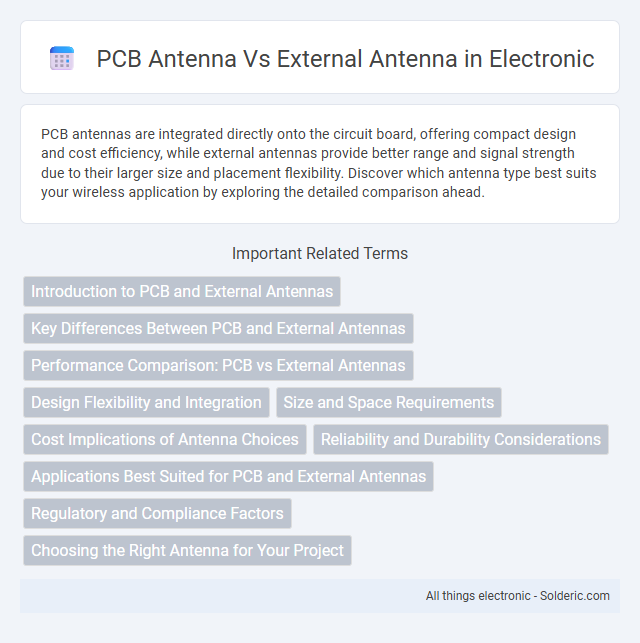PCB antennas are integrated directly onto the circuit board, offering compact design and cost efficiency, while external antennas provide better range and signal strength due to their larger size and placement flexibility. Discover which antenna type best suits your wireless application by exploring the detailed comparison ahead.
Comparison Table
| Feature | PCB Antenna | External Antenna |
|---|---|---|
| Size | Compact, integrated on PCB | Larger, separate component |
| Cost | Low cost, no extra parts | Higher cost, requires connectors |
| Performance | Limited range and gain | Higher gain, better range |
| Design Complexity | Requires precise PCB layout | Simpler PCB, antenna added externally |
| Durability | Protected inside device | Exposed, prone to damage |
| Flexibility | Fixed, not easily changed | Replaceable and upgradeable |
| Applications | Small devices, cost-sensitive projects | High-performance devices, long-range needs |
Introduction to PCB and External Antennas
PCB antennas are integrated directly onto the printed circuit board, offering compact size and low cost ideal for space-constrained devices, while external antennas are separate components that provide better signal strength and range due to larger size and optimized placement. PCB antennas leverage the board's conductive layers and require precise design to ensure efficient radiation, whereas external antennas can be easily replaced or upgraded to suit different frequency bands and environmental conditions. Device manufacturers often choose PCB antennas for sleek, integrated designs, and external antennas when maximum performance and flexibility in antenna positioning are critical.
Key Differences Between PCB and External Antennas
PCB antennas are integrated directly onto the circuit board, providing a compact and cost-effective solution with limited range and flexibility. External antennas, mounted outside the device housing, offer superior signal strength, improved range, and greater design versatility, ideal for applications demanding high performance. Key differences include size, installation complexity, signal gain, and susceptibility to environmental interference, with external antennas generally excelling in stronger connectivity and adaptability.
Performance Comparison: PCB vs External Antennas
PCB antennas offer compact design and cost efficiency but generally provide lower gain and limited range compared to external antennas, which deliver superior signal strength and more consistent performance in varied environments. External antennas allow better tuning and placement flexibility, enhancing overall connectivity and reducing interference, crucial for applications requiring reliable long-distance communication. Your choice between PCB and external antennas directly impacts device performance, balancing size constraints against the need for optimized signal quality and range.
Design Flexibility and Integration
PCB antennas offer superior design flexibility by allowing seamless integration directly onto the circuit board, reducing overall size and assembly complexity. External antennas, while providing potentially better signal range, require additional connectors and space, complicating device layout and increasing manufacturing costs. Integration of PCB antennas is ideal for compact, cost-sensitive applications where streamlined production and consistent performance are essential.
Size and Space Requirements
PCB antennas offer a compact and integrated solution that significantly saves space on your device's design, making them ideal for small or lightweight applications. External antennas, although requiring additional space outside the device, often provide superior range and signal quality due to their larger size and optimized placement. Considering your specific size constraints and space requirements is crucial in choosing between the compactness of PCB antennas and the performance advantages of external antennas.
Cost Implications of Antenna Choices
PCB antennas offer a cost-effective solution by integrating the antenna directly onto the circuit board, eliminating the need for separate components and reducing assembly expenses. External antennas, while often providing better signal strength and range, increase overall device cost due to additional materials, connectors, and manufacturing complexity. Selecting between PCB and external antennas depends on balancing budget constraints with performance requirements in the device design.
Reliability and Durability Considerations
PCB antennas offer enhanced reliability and durability due to their integration within the device's printed circuit board, minimizing exposure to environmental factors such as moisture, dust, and mechanical stress. External antennas, while often providing stronger signal performance, are more susceptible to physical damage and wear from handling or environmental conditions, potentially compromising long-term performance. Your choice should balance the need for robust, maintenance-free operation with the desired signal strength and device design constraints.
Applications Best Suited for PCB and External Antennas
PCB antennas are best suited for compact, low-profile devices such as smartphones, wearable technology, and IoT gadgets where space saving and cost efficiency are critical. External antennas excel in applications requiring extended range and higher signal strength, including outdoor routers, drones, and industrial equipment operating in challenging environments. Choosing the right antenna impacts your device's performance, especially in environments with variable signal conditions and specific power requirements.
Regulatory and Compliance Factors
PCB antennas are preferred in regulatory and compliance contexts due to their integrated design, which facilitates tighter control over electromagnetic interference (EMI) and easier certification processes under standards such as FCC, CE, and ETSI. External antennas may introduce variability in emission patterns and impedance matching, complicating regulatory approval and requiring more rigorous testing to meet radiated emission limits. Device manufacturers often favor PCB antennas to streamline compliance documentation and ensure consistent performance across production batches.
Choosing the Right Antenna for Your Project
PCB antennas offer a compact, cost-effective solution with integrated design, ideal for space-constrained projects requiring moderate range and reliability. External antennas provide superior gain and flexibility, enhancing signal strength in challenging environments or longer-range applications. Choosing the right antenna for your project depends on factors such as size constraints, performance requirements, and environmental conditions to ensure optimal wireless communication.
PCB antenna vs external antenna Infographic

 solderic.com
solderic.com